Critical Evaluation of Manager's Role in Employee Retention: Starbucks
VerifiedAdded on 2023/06/18
|27
|5895
|266
Case Study
AI Summary
This case study critically evaluates the role of managers in employee retention at Starbucks, focusing on talent management strategies. It explores the challenges faced by Starbucks managers, such as salary dissatisfaction and employee-employer relationship issues, and proposes solutions like competitive compensation, rewards, and improved communication. The research employs a deductive approach and survey strategy, gathering data from Starbucks employees to assess the impact of managerial practices on staff retention. The findings aim to provide insights for Starbucks and other organizations to enhance employee motivation and reduce turnover by effectively leveraging the role of managers in talent management.
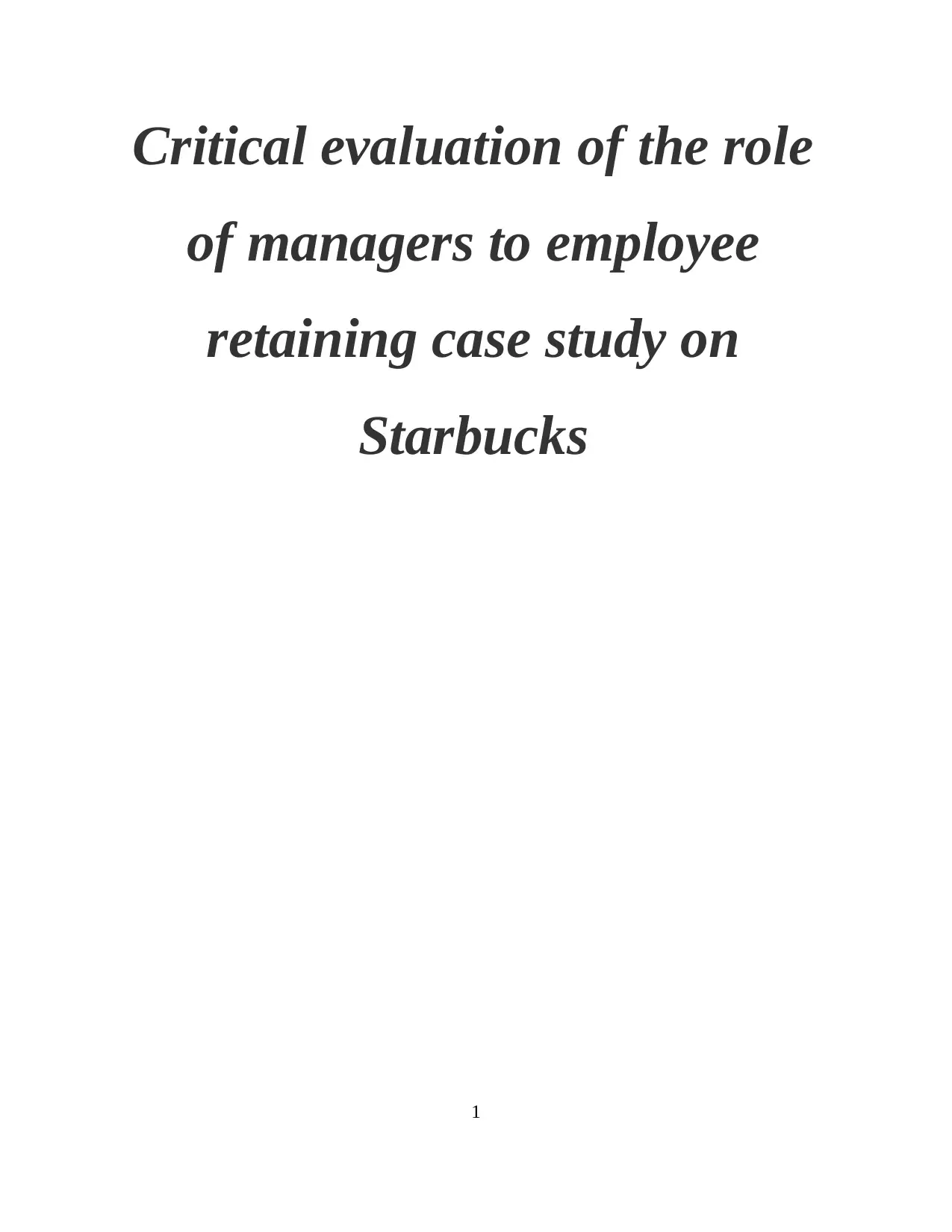
Critical evaluation of the role
of managers to employee
retaining case study on
Starbucks
1
of managers to employee
retaining case study on
Starbucks
1
Paraphrase This Document
Need a fresh take? Get an instant paraphrase of this document with our AI Paraphraser
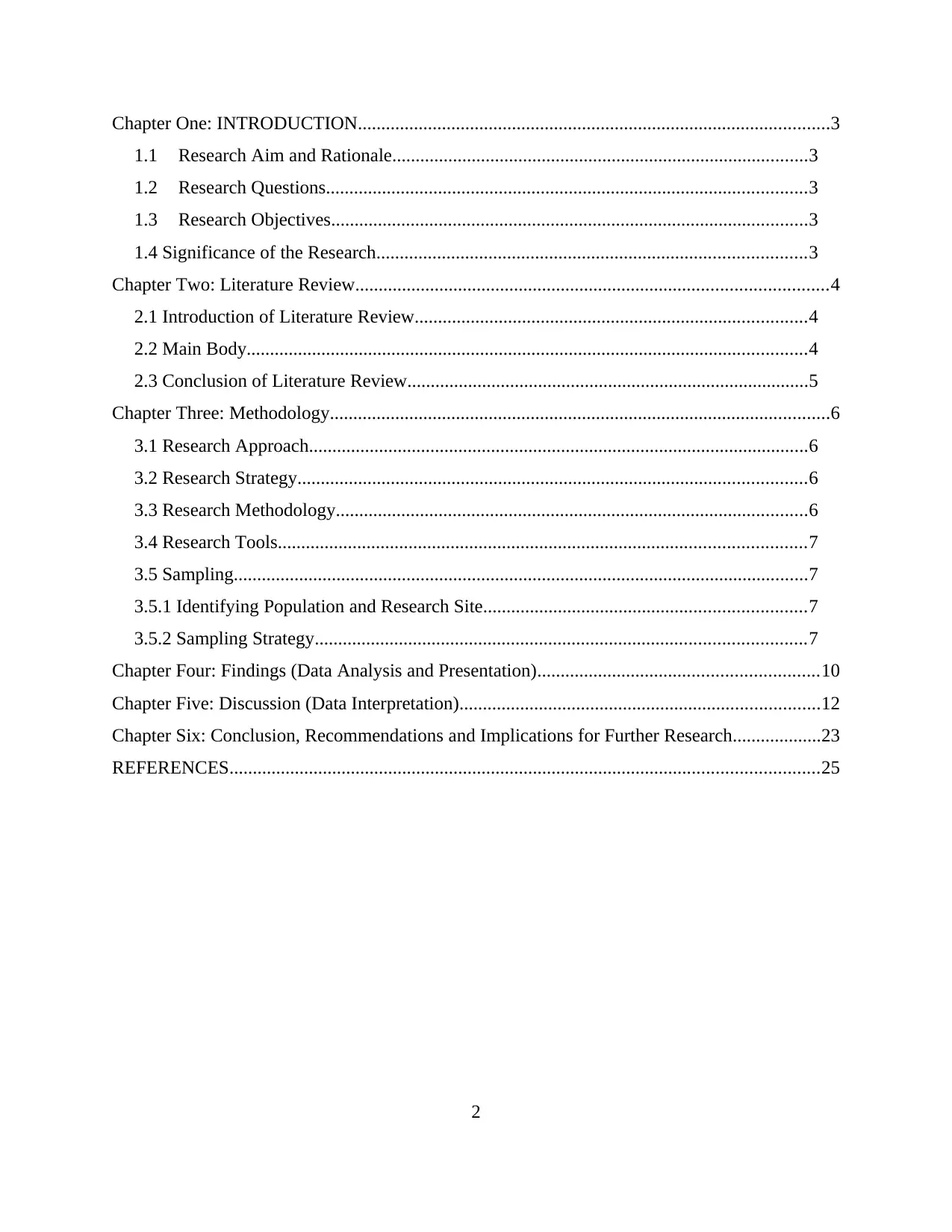
Chapter One: INTRODUCTION.....................................................................................................3
1.1 Research Aim and Rationale.........................................................................................3
1.2 Research Questions.......................................................................................................3
1.3 Research Objectives......................................................................................................3
1.4 Significance of the Research............................................................................................3
Chapter Two: Literature Review.....................................................................................................4
2.1 Introduction of Literature Review....................................................................................4
2.2 Main Body........................................................................................................................4
2.3 Conclusion of Literature Review......................................................................................5
Chapter Three: Methodology...........................................................................................................6
3.1 Research Approach...........................................................................................................6
3.2 Research Strategy.............................................................................................................6
3.3 Research Methodology.....................................................................................................6
3.4 Research Tools.................................................................................................................7
3.5 Sampling...........................................................................................................................7
3.5.1 Identifying Population and Research Site.....................................................................7
3.5.2 Sampling Strategy.........................................................................................................7
Chapter Four: Findings (Data Analysis and Presentation)............................................................10
Chapter Five: Discussion (Data Interpretation).............................................................................12
Chapter Six: Conclusion, Recommendations and Implications for Further Research...................23
REFERENCES..............................................................................................................................25
2
1.1 Research Aim and Rationale.........................................................................................3
1.2 Research Questions.......................................................................................................3
1.3 Research Objectives......................................................................................................3
1.4 Significance of the Research............................................................................................3
Chapter Two: Literature Review.....................................................................................................4
2.1 Introduction of Literature Review....................................................................................4
2.2 Main Body........................................................................................................................4
2.3 Conclusion of Literature Review......................................................................................5
Chapter Three: Methodology...........................................................................................................6
3.1 Research Approach...........................................................................................................6
3.2 Research Strategy.............................................................................................................6
3.3 Research Methodology.....................................................................................................6
3.4 Research Tools.................................................................................................................7
3.5 Sampling...........................................................................................................................7
3.5.1 Identifying Population and Research Site.....................................................................7
3.5.2 Sampling Strategy.........................................................................................................7
Chapter Four: Findings (Data Analysis and Presentation)............................................................10
Chapter Five: Discussion (Data Interpretation).............................................................................12
Chapter Six: Conclusion, Recommendations and Implications for Further Research...................23
REFERENCES..............................................................................................................................25
2
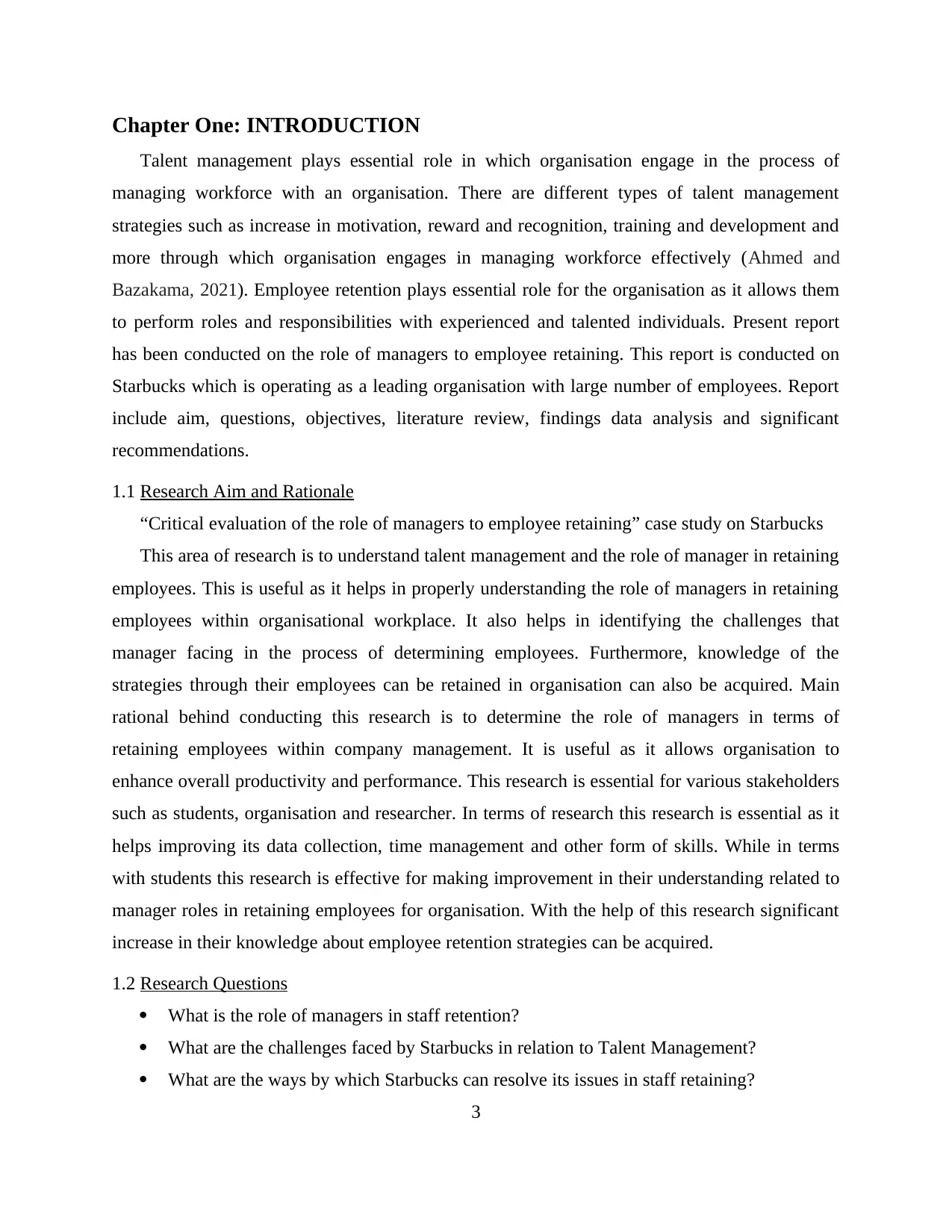
Chapter One: INTRODUCTION
Talent management plays essential role in which organisation engage in the process of
managing workforce with an organisation. There are different types of talent management
strategies such as increase in motivation, reward and recognition, training and development and
more through which organisation engages in managing workforce effectively (Ahmed and
Bazakama, 2021). Employee retention plays essential role for the organisation as it allows them
to perform roles and responsibilities with experienced and talented individuals. Present report
has been conducted on the role of managers to employee retaining. This report is conducted on
Starbucks which is operating as a leading organisation with large number of employees. Report
include aim, questions, objectives, literature review, findings data analysis and significant
recommendations.
1.1 Research Aim and Rationale
“Critical evaluation of the role of managers to employee retaining” case study on Starbucks
This area of research is to understand talent management and the role of manager in retaining
employees. This is useful as it helps in properly understanding the role of managers in retaining
employees within organisational workplace. It also helps in identifying the challenges that
manager facing in the process of determining employees. Furthermore, knowledge of the
strategies through their employees can be retained in organisation can also be acquired. Main
rational behind conducting this research is to determine the role of managers in terms of
retaining employees within company management. It is useful as it allows organisation to
enhance overall productivity and performance. This research is essential for various stakeholders
such as students, organisation and researcher. In terms of research this research is essential as it
helps improving its data collection, time management and other form of skills. While in terms
with students this research is effective for making improvement in their understanding related to
manager roles in retaining employees for organisation. With the help of this research significant
increase in their knowledge about employee retention strategies can be acquired.
1.2 Research Questions
What is the role of managers in staff retention?
What are the challenges faced by Starbucks in relation to Talent Management?
What are the ways by which Starbucks can resolve its issues in staff retaining?
3
Talent management plays essential role in which organisation engage in the process of
managing workforce with an organisation. There are different types of talent management
strategies such as increase in motivation, reward and recognition, training and development and
more through which organisation engages in managing workforce effectively (Ahmed and
Bazakama, 2021). Employee retention plays essential role for the organisation as it allows them
to perform roles and responsibilities with experienced and talented individuals. Present report
has been conducted on the role of managers to employee retaining. This report is conducted on
Starbucks which is operating as a leading organisation with large number of employees. Report
include aim, questions, objectives, literature review, findings data analysis and significant
recommendations.
1.1 Research Aim and Rationale
“Critical evaluation of the role of managers to employee retaining” case study on Starbucks
This area of research is to understand talent management and the role of manager in retaining
employees. This is useful as it helps in properly understanding the role of managers in retaining
employees within organisational workplace. It also helps in identifying the challenges that
manager facing in the process of determining employees. Furthermore, knowledge of the
strategies through their employees can be retained in organisation can also be acquired. Main
rational behind conducting this research is to determine the role of managers in terms of
retaining employees within company management. It is useful as it allows organisation to
enhance overall productivity and performance. This research is essential for various stakeholders
such as students, organisation and researcher. In terms of research this research is essential as it
helps improving its data collection, time management and other form of skills. While in terms
with students this research is effective for making improvement in their understanding related to
manager roles in retaining employees for organisation. With the help of this research significant
increase in their knowledge about employee retention strategies can be acquired.
1.2 Research Questions
What is the role of managers in staff retention?
What are the challenges faced by Starbucks in relation to Talent Management?
What are the ways by which Starbucks can resolve its issues in staff retaining?
3
⊘ This is a preview!⊘
Do you want full access?
Subscribe today to unlock all pages.

Trusted by 1+ million students worldwide
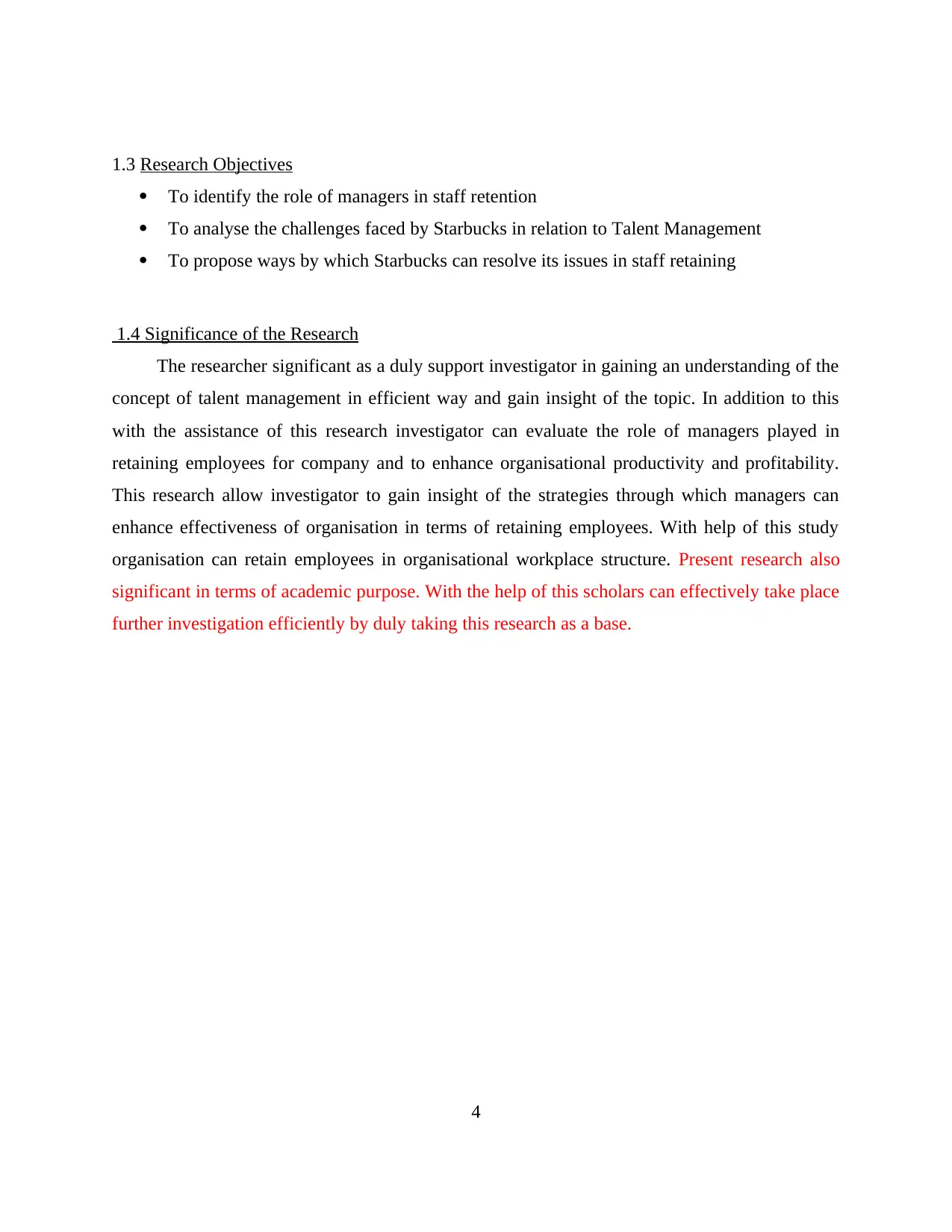
1.3 Research Objectives
To identify the role of managers in staff retention
To analyse the challenges faced by Starbucks in relation to Talent Management
To propose ways by which Starbucks can resolve its issues in staff retaining
1.4 Significance of the Research
The researcher significant as a duly support investigator in gaining an understanding of the
concept of talent management in efficient way and gain insight of the topic. In addition to this
with the assistance of this research investigator can evaluate the role of managers played in
retaining employees for company and to enhance organisational productivity and profitability.
This research allow investigator to gain insight of the strategies through which managers can
enhance effectiveness of organisation in terms of retaining employees. With help of this study
organisation can retain employees in organisational workplace structure. Present research also
significant in terms of academic purpose. With the help of this scholars can effectively take place
further investigation efficiently by duly taking this research as a base.
4
To identify the role of managers in staff retention
To analyse the challenges faced by Starbucks in relation to Talent Management
To propose ways by which Starbucks can resolve its issues in staff retaining
1.4 Significance of the Research
The researcher significant as a duly support investigator in gaining an understanding of the
concept of talent management in efficient way and gain insight of the topic. In addition to this
with the assistance of this research investigator can evaluate the role of managers played in
retaining employees for company and to enhance organisational productivity and profitability.
This research allow investigator to gain insight of the strategies through which managers can
enhance effectiveness of organisation in terms of retaining employees. With help of this study
organisation can retain employees in organisational workplace structure. Present research also
significant in terms of academic purpose. With the help of this scholars can effectively take place
further investigation efficiently by duly taking this research as a base.
4
Paraphrase This Document
Need a fresh take? Get an instant paraphrase of this document with our AI Paraphraser
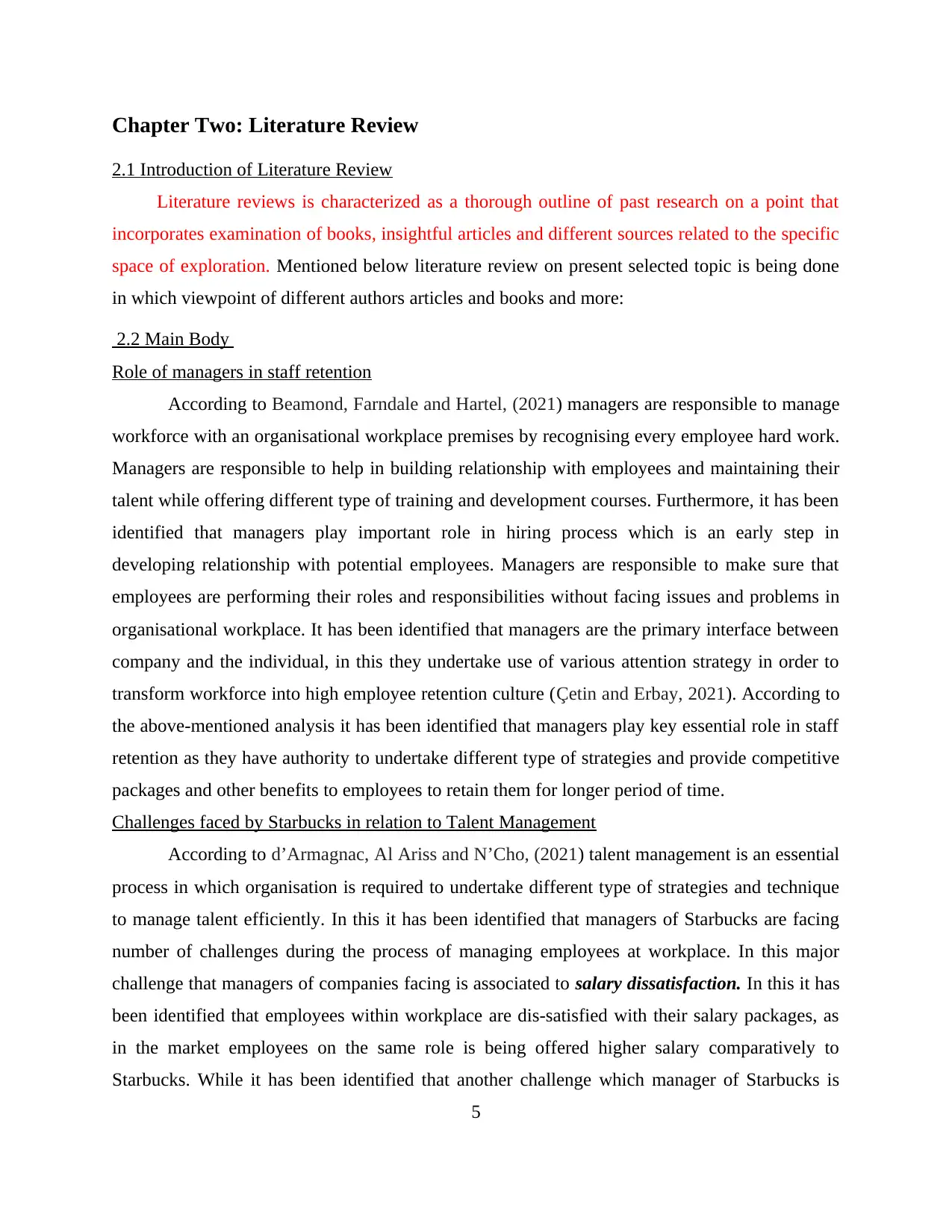
Chapter Two: Literature Review
2.1 Introduction of Literature Review
Literature reviews is characterized as a thorough outline of past research on a point that
incorporates examination of books, insightful articles and different sources related to the specific
space of exploration. Mentioned below literature review on present selected topic is being done
in which viewpoint of different authors articles and books and more:
2.2 Main Body
Role of managers in staff retention
According to Beamond, Farndale and Hartel, (2021) managers are responsible to manage
workforce with an organisational workplace premises by recognising every employee hard work.
Managers are responsible to help in building relationship with employees and maintaining their
talent while offering different type of training and development courses. Furthermore, it has been
identified that managers play important role in hiring process which is an early step in
developing relationship with potential employees. Managers are responsible to make sure that
employees are performing their roles and responsibilities without facing issues and problems in
organisational workplace. It has been identified that managers are the primary interface between
company and the individual, in this they undertake use of various attention strategy in order to
transform workforce into high employee retention culture (Çetin and Erbay, 2021). According to
the above-mentioned analysis it has been identified that managers play key essential role in staff
retention as they have authority to undertake different type of strategies and provide competitive
packages and other benefits to employees to retain them for longer period of time.
Challenges faced by Starbucks in relation to Talent Management
According to d’Armagnac, Al Ariss and N’Cho, (2021) talent management is an essential
process in which organisation is required to undertake different type of strategies and technique
to manage talent efficiently. In this it has been identified that managers of Starbucks are facing
number of challenges during the process of managing employees at workplace. In this major
challenge that managers of companies facing is associated to salary dissatisfaction. In this it has
been identified that employees within workplace are dis-satisfied with their salary packages, as
in the market employees on the same role is being offered higher salary comparatively to
Starbucks. While it has been identified that another challenge which manager of Starbucks is
5
2.1 Introduction of Literature Review
Literature reviews is characterized as a thorough outline of past research on a point that
incorporates examination of books, insightful articles and different sources related to the specific
space of exploration. Mentioned below literature review on present selected topic is being done
in which viewpoint of different authors articles and books and more:
2.2 Main Body
Role of managers in staff retention
According to Beamond, Farndale and Hartel, (2021) managers are responsible to manage
workforce with an organisational workplace premises by recognising every employee hard work.
Managers are responsible to help in building relationship with employees and maintaining their
talent while offering different type of training and development courses. Furthermore, it has been
identified that managers play important role in hiring process which is an early step in
developing relationship with potential employees. Managers are responsible to make sure that
employees are performing their roles and responsibilities without facing issues and problems in
organisational workplace. It has been identified that managers are the primary interface between
company and the individual, in this they undertake use of various attention strategy in order to
transform workforce into high employee retention culture (Çetin and Erbay, 2021). According to
the above-mentioned analysis it has been identified that managers play key essential role in staff
retention as they have authority to undertake different type of strategies and provide competitive
packages and other benefits to employees to retain them for longer period of time.
Challenges faced by Starbucks in relation to Talent Management
According to d’Armagnac, Al Ariss and N’Cho, (2021) talent management is an essential
process in which organisation is required to undertake different type of strategies and technique
to manage talent efficiently. In this it has been identified that managers of Starbucks are facing
number of challenges during the process of managing employees at workplace. In this major
challenge that managers of companies facing is associated to salary dissatisfaction. In this it has
been identified that employees within workplace are dis-satisfied with their salary packages, as
in the market employees on the same role is being offered higher salary comparatively to
Starbucks. While it has been identified that another challenge which manager of Starbucks is
5
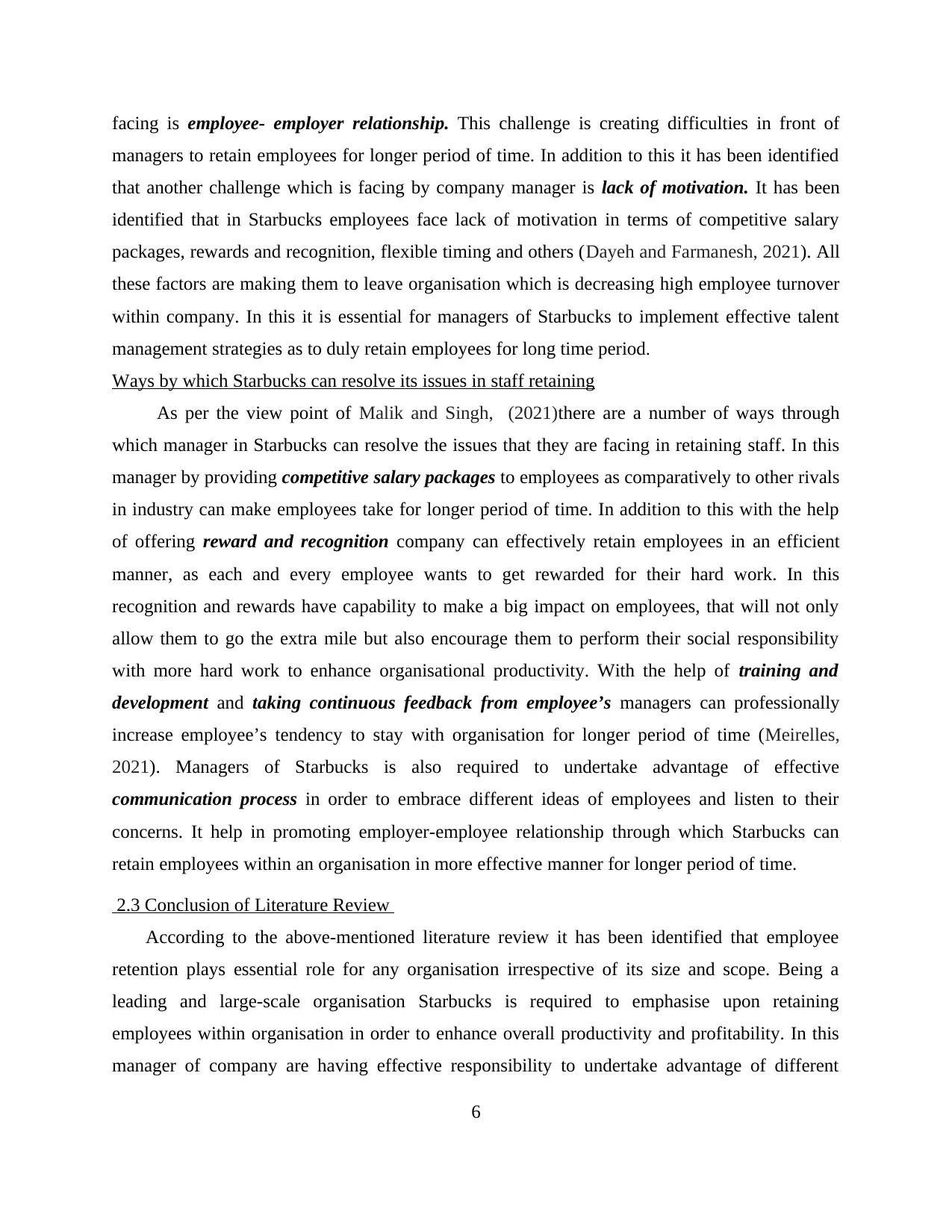
facing is employee- employer relationship. This challenge is creating difficulties in front of
managers to retain employees for longer period of time. In addition to this it has been identified
that another challenge which is facing by company manager is lack of motivation. It has been
identified that in Starbucks employees face lack of motivation in terms of competitive salary
packages, rewards and recognition, flexible timing and others (Dayeh and Farmanesh, 2021). All
these factors are making them to leave organisation which is decreasing high employee turnover
within company. In this it is essential for managers of Starbucks to implement effective talent
management strategies as to duly retain employees for long time period.
Ways by which Starbucks can resolve its issues in staff retaining
As per the view point of Malik and Singh, (2021)there are a number of ways through
which manager in Starbucks can resolve the issues that they are facing in retaining staff. In this
manager by providing competitive salary packages to employees as comparatively to other rivals
in industry can make employees take for longer period of time. In addition to this with the help
of offering reward and recognition company can effectively retain employees in an efficient
manner, as each and every employee wants to get rewarded for their hard work. In this
recognition and rewards have capability to make a big impact on employees, that will not only
allow them to go the extra mile but also encourage them to perform their social responsibility
with more hard work to enhance organisational productivity. With the help of training and
development and taking continuous feedback from employee’s managers can professionally
increase employee’s tendency to stay with organisation for longer period of time (Meirelles,
2021). Managers of Starbucks is also required to undertake advantage of effective
communication process in order to embrace different ideas of employees and listen to their
concerns. It help in promoting employer-employee relationship through which Starbucks can
retain employees within an organisation in more effective manner for longer period of time.
2.3 Conclusion of Literature Review
According to the above-mentioned literature review it has been identified that employee
retention plays essential role for any organisation irrespective of its size and scope. Being a
leading and large-scale organisation Starbucks is required to emphasise upon retaining
employees within organisation in order to enhance overall productivity and profitability. In this
manager of company are having effective responsibility to undertake advantage of different
6
managers to retain employees for longer period of time. In addition to this it has been identified
that another challenge which is facing by company manager is lack of motivation. It has been
identified that in Starbucks employees face lack of motivation in terms of competitive salary
packages, rewards and recognition, flexible timing and others (Dayeh and Farmanesh, 2021). All
these factors are making them to leave organisation which is decreasing high employee turnover
within company. In this it is essential for managers of Starbucks to implement effective talent
management strategies as to duly retain employees for long time period.
Ways by which Starbucks can resolve its issues in staff retaining
As per the view point of Malik and Singh, (2021)there are a number of ways through
which manager in Starbucks can resolve the issues that they are facing in retaining staff. In this
manager by providing competitive salary packages to employees as comparatively to other rivals
in industry can make employees take for longer period of time. In addition to this with the help
of offering reward and recognition company can effectively retain employees in an efficient
manner, as each and every employee wants to get rewarded for their hard work. In this
recognition and rewards have capability to make a big impact on employees, that will not only
allow them to go the extra mile but also encourage them to perform their social responsibility
with more hard work to enhance organisational productivity. With the help of training and
development and taking continuous feedback from employee’s managers can professionally
increase employee’s tendency to stay with organisation for longer period of time (Meirelles,
2021). Managers of Starbucks is also required to undertake advantage of effective
communication process in order to embrace different ideas of employees and listen to their
concerns. It help in promoting employer-employee relationship through which Starbucks can
retain employees within an organisation in more effective manner for longer period of time.
2.3 Conclusion of Literature Review
According to the above-mentioned literature review it has been identified that employee
retention plays essential role for any organisation irrespective of its size and scope. Being a
leading and large-scale organisation Starbucks is required to emphasise upon retaining
employees within organisation in order to enhance overall productivity and profitability. In this
manager of company are having effective responsibility to undertake advantage of different
6
⊘ This is a preview!⊘
Do you want full access?
Subscribe today to unlock all pages.

Trusted by 1+ million students worldwide
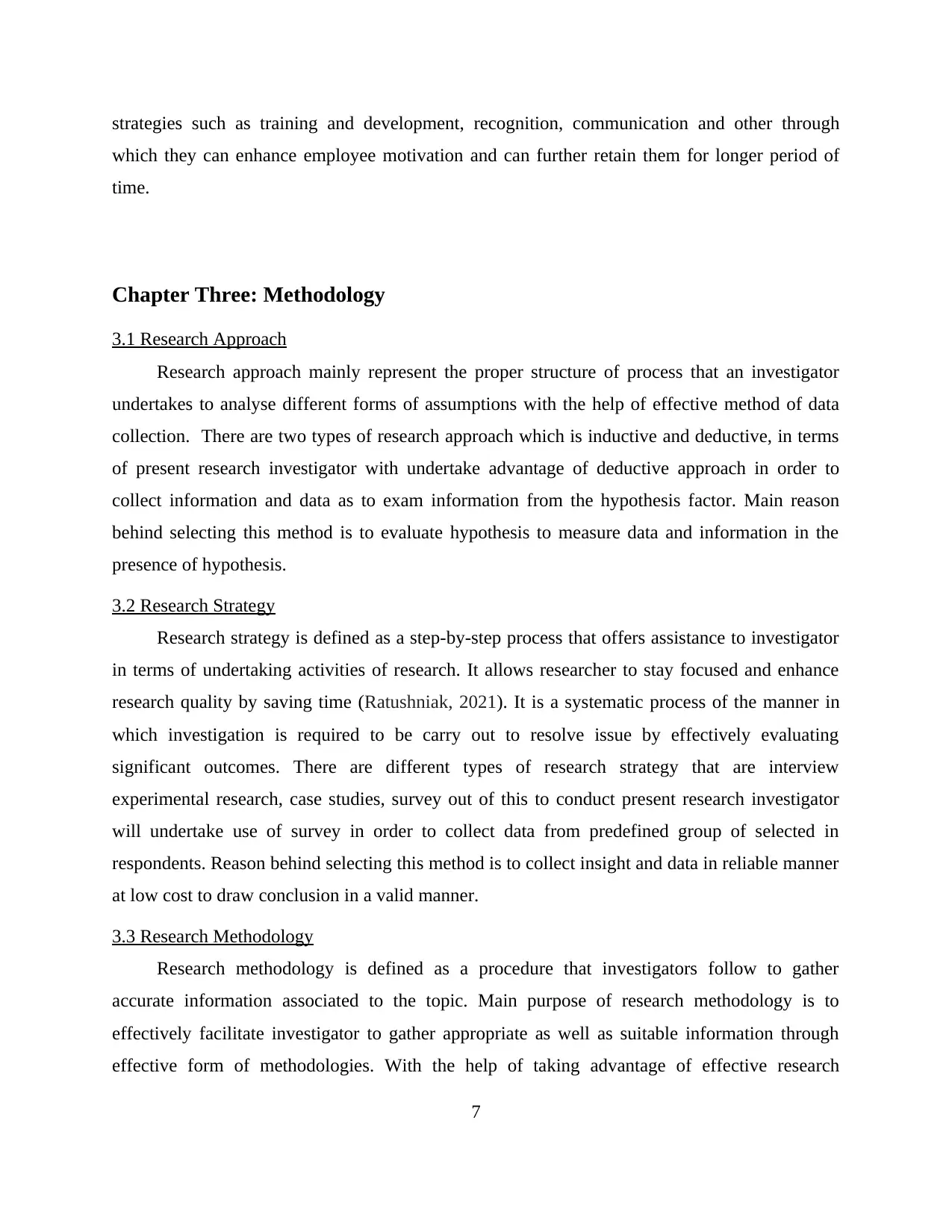
strategies such as training and development, recognition, communication and other through
which they can enhance employee motivation and can further retain them for longer period of
time.
Chapter Three: Methodology
3.1 Research Approach
Research approach mainly represent the proper structure of process that an investigator
undertakes to analyse different forms of assumptions with the help of effective method of data
collection. There are two types of research approach which is inductive and deductive, in terms
of present research investigator with undertake advantage of deductive approach in order to
collect information and data as to exam information from the hypothesis factor. Main reason
behind selecting this method is to evaluate hypothesis to measure data and information in the
presence of hypothesis.
3.2 Research Strategy
Research strategy is defined as a step-by-step process that offers assistance to investigator
in terms of undertaking activities of research. It allows researcher to stay focused and enhance
research quality by saving time (Ratushniak, 2021). It is a systematic process of the manner in
which investigation is required to be carry out to resolve issue by effectively evaluating
significant outcomes. There are different types of research strategy that are interview
experimental research, case studies, survey out of this to conduct present research investigator
will undertake use of survey in order to collect data from predefined group of selected in
respondents. Reason behind selecting this method is to collect insight and data in reliable manner
at low cost to draw conclusion in a valid manner.
3.3 Research Methodology
Research methodology is defined as a procedure that investigators follow to gather
accurate information associated to the topic. Main purpose of research methodology is to
effectively facilitate investigator to gather appropriate as well as suitable information through
effective form of methodologies. With the help of taking advantage of effective research
7
which they can enhance employee motivation and can further retain them for longer period of
time.
Chapter Three: Methodology
3.1 Research Approach
Research approach mainly represent the proper structure of process that an investigator
undertakes to analyse different forms of assumptions with the help of effective method of data
collection. There are two types of research approach which is inductive and deductive, in terms
of present research investigator with undertake advantage of deductive approach in order to
collect information and data as to exam information from the hypothesis factor. Main reason
behind selecting this method is to evaluate hypothesis to measure data and information in the
presence of hypothesis.
3.2 Research Strategy
Research strategy is defined as a step-by-step process that offers assistance to investigator
in terms of undertaking activities of research. It allows researcher to stay focused and enhance
research quality by saving time (Ratushniak, 2021). It is a systematic process of the manner in
which investigation is required to be carry out to resolve issue by effectively evaluating
significant outcomes. There are different types of research strategy that are interview
experimental research, case studies, survey out of this to conduct present research investigator
will undertake use of survey in order to collect data from predefined group of selected in
respondents. Reason behind selecting this method is to collect insight and data in reliable manner
at low cost to draw conclusion in a valid manner.
3.3 Research Methodology
Research methodology is defined as a procedure that investigators follow to gather
accurate information associated to the topic. Main purpose of research methodology is to
effectively facilitate investigator to gather appropriate as well as suitable information through
effective form of methodologies. With the help of taking advantage of effective research
7
Paraphrase This Document
Need a fresh take? Get an instant paraphrase of this document with our AI Paraphraser
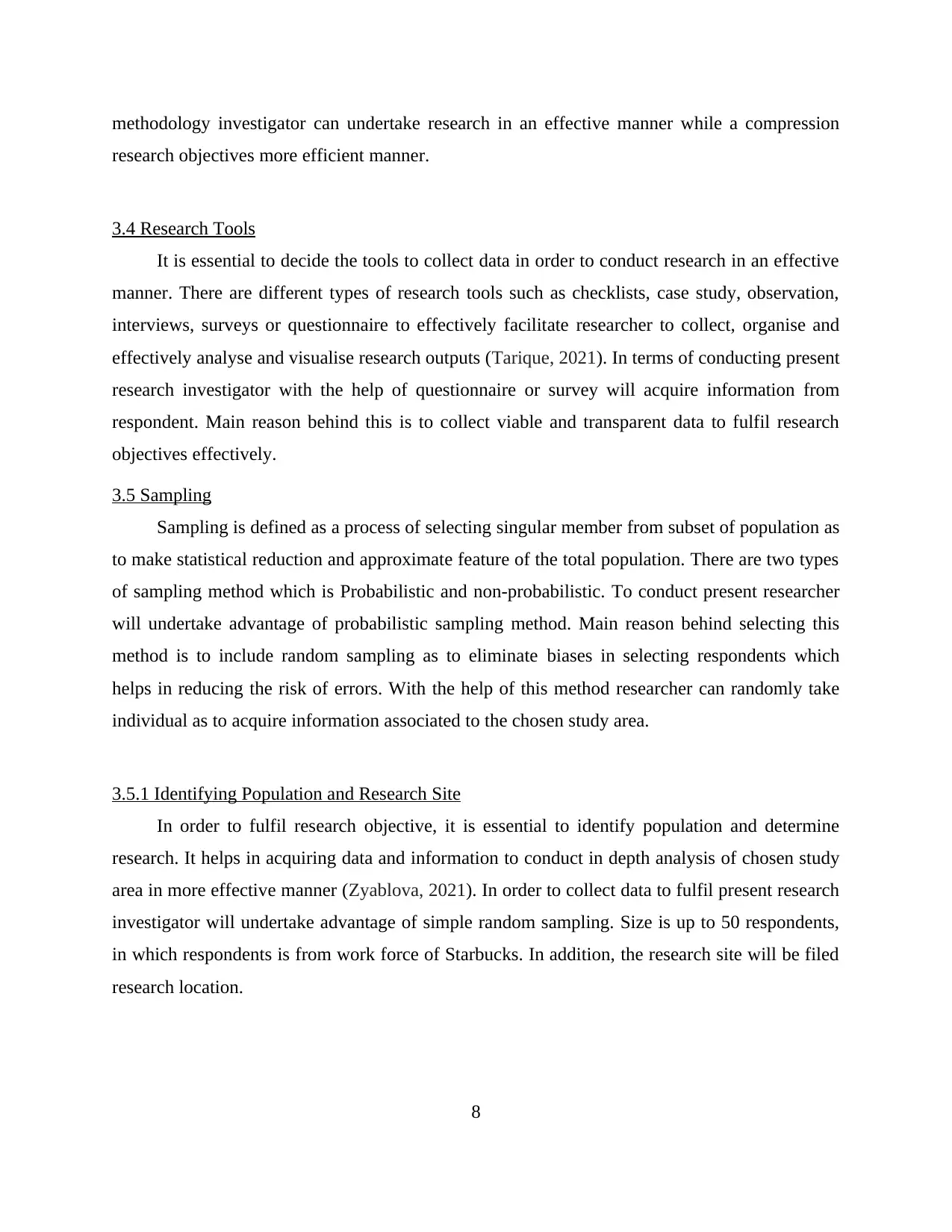
methodology investigator can undertake research in an effective manner while a compression
research objectives more efficient manner.
3.4 Research Tools
It is essential to decide the tools to collect data in order to conduct research in an effective
manner. There are different types of research tools such as checklists, case study, observation,
interviews, surveys or questionnaire to effectively facilitate researcher to collect, organise and
effectively analyse and visualise research outputs (Tarique, 2021). In terms of conducting present
research investigator with the help of questionnaire or survey will acquire information from
respondent. Main reason behind this is to collect viable and transparent data to fulfil research
objectives effectively.
3.5 Sampling
Sampling is defined as a process of selecting singular member from subset of population as
to make statistical reduction and approximate feature of the total population. There are two types
of sampling method which is Probabilistic and non-probabilistic. To conduct present researcher
will undertake advantage of probabilistic sampling method. Main reason behind selecting this
method is to include random sampling as to eliminate biases in selecting respondents which
helps in reducing the risk of errors. With the help of this method researcher can randomly take
individual as to acquire information associated to the chosen study area.
3.5.1 Identifying Population and Research Site
In order to fulfil research objective, it is essential to identify population and determine
research. It helps in acquiring data and information to conduct in depth analysis of chosen study
area in more effective manner (Zyablova, 2021). In order to collect data to fulfil present research
investigator will undertake advantage of simple random sampling. Size is up to 50 respondents,
in which respondents is from work force of Starbucks. In addition, the research site will be filed
research location.
8
research objectives more efficient manner.
3.4 Research Tools
It is essential to decide the tools to collect data in order to conduct research in an effective
manner. There are different types of research tools such as checklists, case study, observation,
interviews, surveys or questionnaire to effectively facilitate researcher to collect, organise and
effectively analyse and visualise research outputs (Tarique, 2021). In terms of conducting present
research investigator with the help of questionnaire or survey will acquire information from
respondent. Main reason behind this is to collect viable and transparent data to fulfil research
objectives effectively.
3.5 Sampling
Sampling is defined as a process of selecting singular member from subset of population as
to make statistical reduction and approximate feature of the total population. There are two types
of sampling method which is Probabilistic and non-probabilistic. To conduct present researcher
will undertake advantage of probabilistic sampling method. Main reason behind selecting this
method is to include random sampling as to eliminate biases in selecting respondents which
helps in reducing the risk of errors. With the help of this method researcher can randomly take
individual as to acquire information associated to the chosen study area.
3.5.1 Identifying Population and Research Site
In order to fulfil research objective, it is essential to identify population and determine
research. It helps in acquiring data and information to conduct in depth analysis of chosen study
area in more effective manner (Zyablova, 2021). In order to collect data to fulfil present research
investigator will undertake advantage of simple random sampling. Size is up to 50 respondents,
in which respondents is from work force of Starbucks. In addition, the research site will be filed
research location.
8
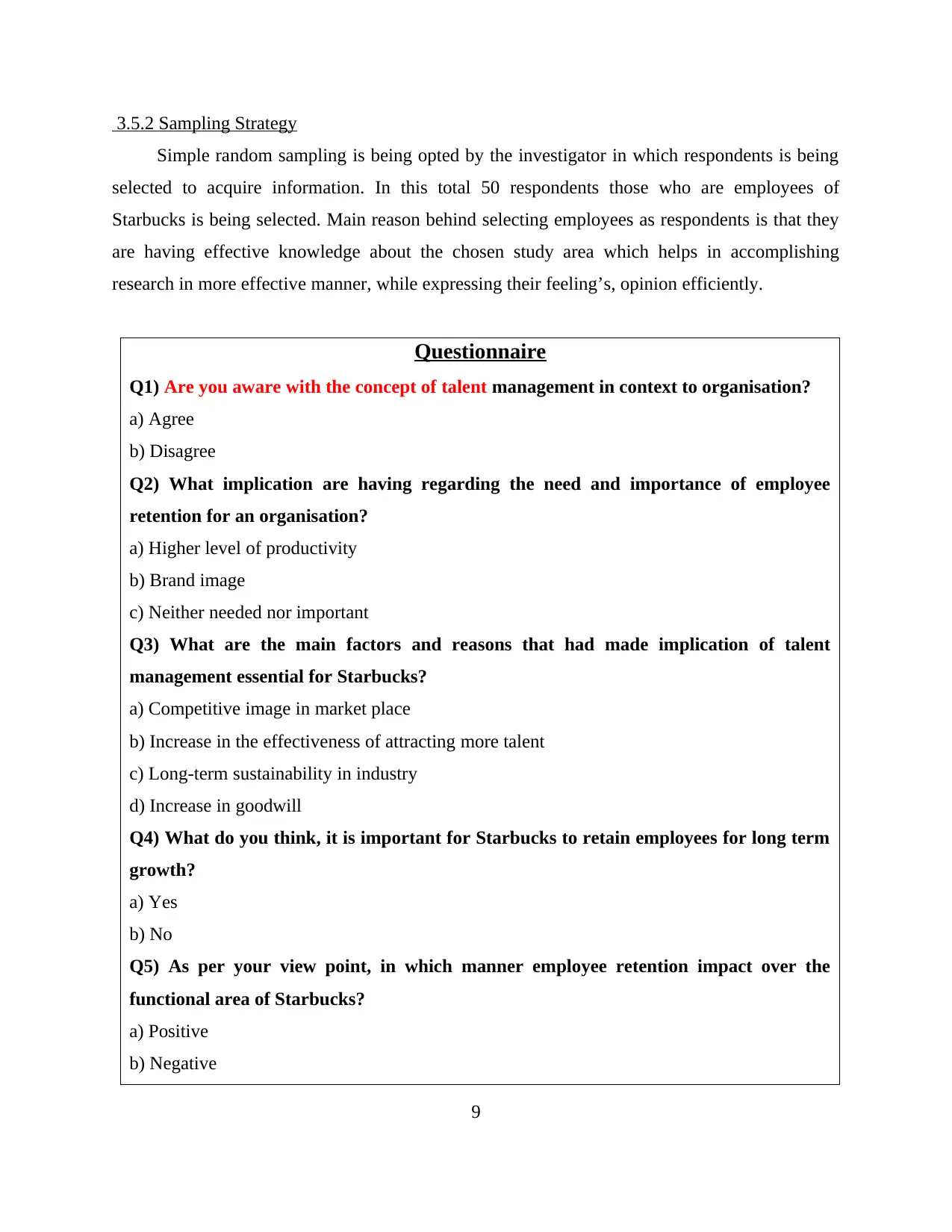
3.5.2 Sampling Strategy
Simple random sampling is being opted by the investigator in which respondents is being
selected to acquire information. In this total 50 respondents those who are employees of
Starbucks is being selected. Main reason behind selecting employees as respondents is that they
are having effective knowledge about the chosen study area which helps in accomplishing
research in more effective manner, while expressing their feeling’s, opinion efficiently.
Questionnaire
Q1) Are you aware with the concept of talent management in context to organisation?
a) Agree
b) Disagree
Q2) What implication are having regarding the need and importance of employee
retention for an organisation?
a) Higher level of productivity
b) Brand image
c) Neither needed nor important
Q3) What are the main factors and reasons that had made implication of talent
management essential for Starbucks?
a) Competitive image in market place
b) Increase in the effectiveness of attracting more talent
c) Long-term sustainability in industry
d) Increase in goodwill
Q4) What do you think, it is important for Starbucks to retain employees for long term
growth?
a) Yes
b) No
Q5) As per your view point, in which manner employee retention impact over the
functional area of Starbucks?
a) Positive
b) Negative
9
Simple random sampling is being opted by the investigator in which respondents is being
selected to acquire information. In this total 50 respondents those who are employees of
Starbucks is being selected. Main reason behind selecting employees as respondents is that they
are having effective knowledge about the chosen study area which helps in accomplishing
research in more effective manner, while expressing their feeling’s, opinion efficiently.
Questionnaire
Q1) Are you aware with the concept of talent management in context to organisation?
a) Agree
b) Disagree
Q2) What implication are having regarding the need and importance of employee
retention for an organisation?
a) Higher level of productivity
b) Brand image
c) Neither needed nor important
Q3) What are the main factors and reasons that had made implication of talent
management essential for Starbucks?
a) Competitive image in market place
b) Increase in the effectiveness of attracting more talent
c) Long-term sustainability in industry
d) Increase in goodwill
Q4) What do you think, it is important for Starbucks to retain employees for long term
growth?
a) Yes
b) No
Q5) As per your view point, in which manner employee retention impact over the
functional area of Starbucks?
a) Positive
b) Negative
9
⊘ This is a preview!⊘
Do you want full access?
Subscribe today to unlock all pages.

Trusted by 1+ million students worldwide
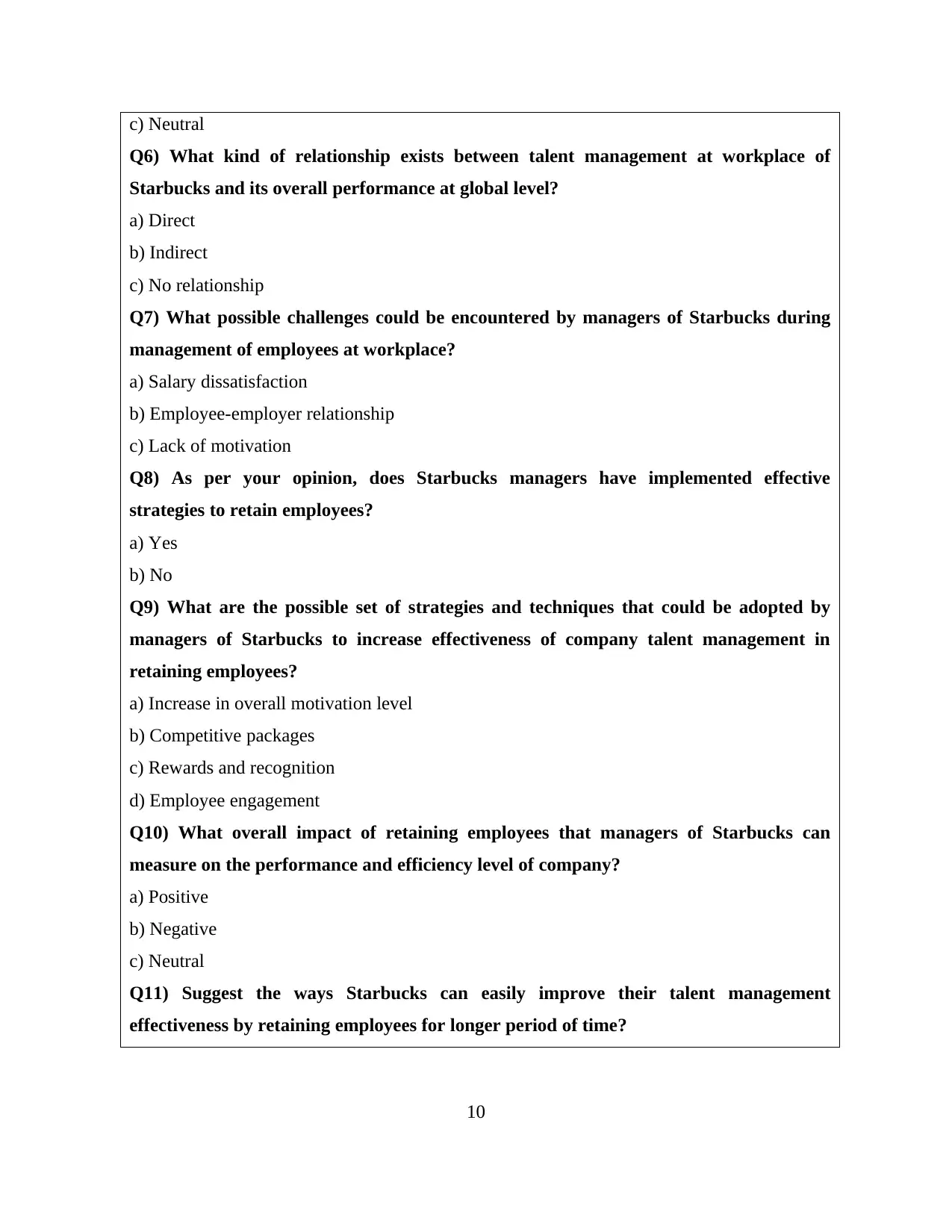
c) Neutral
Q6) What kind of relationship exists between talent management at workplace of
Starbucks and its overall performance at global level?
a) Direct
b) Indirect
c) No relationship
Q7) What possible challenges could be encountered by managers of Starbucks during
management of employees at workplace?
a) Salary dissatisfaction
b) Employee-employer relationship
c) Lack of motivation
Q8) As per your opinion, does Starbucks managers have implemented effective
strategies to retain employees?
a) Yes
b) No
Q9) What are the possible set of strategies and techniques that could be adopted by
managers of Starbucks to increase effectiveness of company talent management in
retaining employees?
a) Increase in overall motivation level
b) Competitive packages
c) Rewards and recognition
d) Employee engagement
Q10) What overall impact of retaining employees that managers of Starbucks can
measure on the performance and efficiency level of company?
a) Positive
b) Negative
c) Neutral
Q11) Suggest the ways Starbucks can easily improve their talent management
effectiveness by retaining employees for longer period of time?
10
Q6) What kind of relationship exists between talent management at workplace of
Starbucks and its overall performance at global level?
a) Direct
b) Indirect
c) No relationship
Q7) What possible challenges could be encountered by managers of Starbucks during
management of employees at workplace?
a) Salary dissatisfaction
b) Employee-employer relationship
c) Lack of motivation
Q8) As per your opinion, does Starbucks managers have implemented effective
strategies to retain employees?
a) Yes
b) No
Q9) What are the possible set of strategies and techniques that could be adopted by
managers of Starbucks to increase effectiveness of company talent management in
retaining employees?
a) Increase in overall motivation level
b) Competitive packages
c) Rewards and recognition
d) Employee engagement
Q10) What overall impact of retaining employees that managers of Starbucks can
measure on the performance and efficiency level of company?
a) Positive
b) Negative
c) Neutral
Q11) Suggest the ways Starbucks can easily improve their talent management
effectiveness by retaining employees for longer period of time?
10
Paraphrase This Document
Need a fresh take? Get an instant paraphrase of this document with our AI Paraphraser
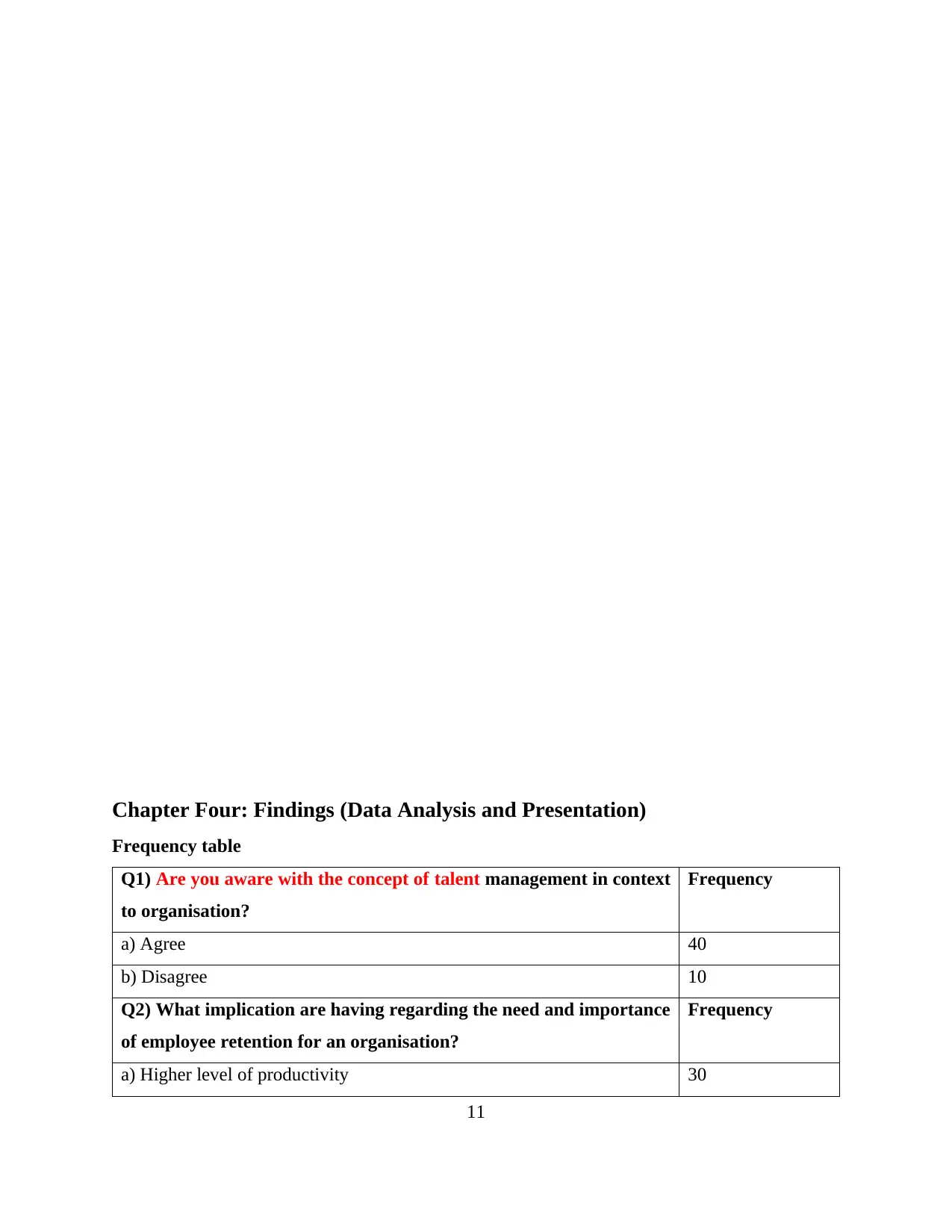
Chapter Four: Findings (Data Analysis and Presentation)
Frequency table
Q1) Are you aware with the concept of talent management in context
to organisation?
Frequency
a) Agree 40
b) Disagree 10
Q2) What implication are having regarding the need and importance
of employee retention for an organisation?
Frequency
a) Higher level of productivity 30
11
Frequency table
Q1) Are you aware with the concept of talent management in context
to organisation?
Frequency
a) Agree 40
b) Disagree 10
Q2) What implication are having regarding the need and importance
of employee retention for an organisation?
Frequency
a) Higher level of productivity 30
11
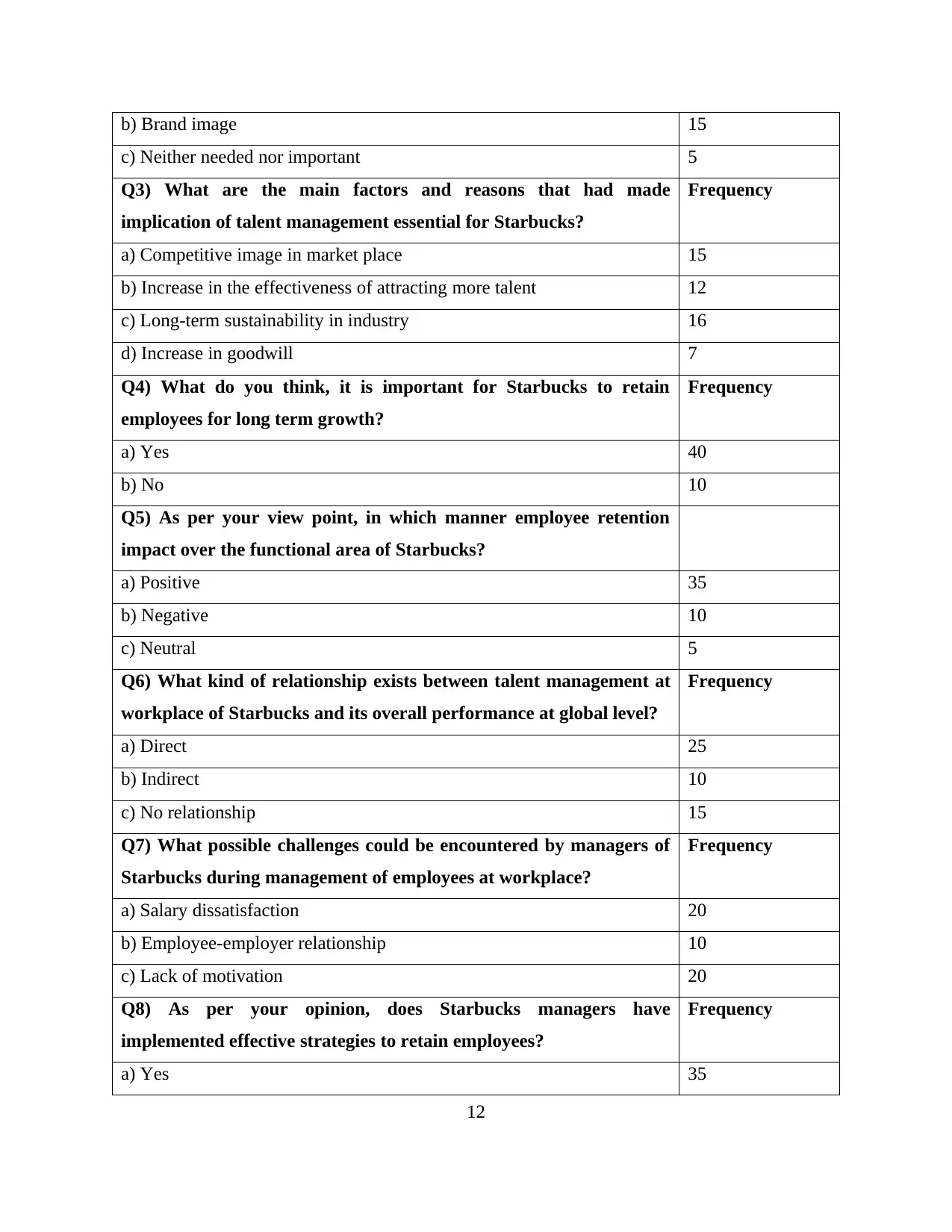
b) Brand image 15
c) Neither needed nor important 5
Q3) What are the main factors and reasons that had made
implication of talent management essential for Starbucks?
Frequency
a) Competitive image in market place 15
b) Increase in the effectiveness of attracting more talent 12
c) Long-term sustainability in industry 16
d) Increase in goodwill 7
Q4) What do you think, it is important for Starbucks to retain
employees for long term growth?
Frequency
a) Yes 40
b) No 10
Q5) As per your view point, in which manner employee retention
impact over the functional area of Starbucks?
a) Positive 35
b) Negative 10
c) Neutral 5
Q6) What kind of relationship exists between talent management at
workplace of Starbucks and its overall performance at global level?
Frequency
a) Direct 25
b) Indirect 10
c) No relationship 15
Q7) What possible challenges could be encountered by managers of
Starbucks during management of employees at workplace?
Frequency
a) Salary dissatisfaction 20
b) Employee-employer relationship 10
c) Lack of motivation 20
Q8) As per your opinion, does Starbucks managers have
implemented effective strategies to retain employees?
Frequency
a) Yes 35
12
c) Neither needed nor important 5
Q3) What are the main factors and reasons that had made
implication of talent management essential for Starbucks?
Frequency
a) Competitive image in market place 15
b) Increase in the effectiveness of attracting more talent 12
c) Long-term sustainability in industry 16
d) Increase in goodwill 7
Q4) What do you think, it is important for Starbucks to retain
employees for long term growth?
Frequency
a) Yes 40
b) No 10
Q5) As per your view point, in which manner employee retention
impact over the functional area of Starbucks?
a) Positive 35
b) Negative 10
c) Neutral 5
Q6) What kind of relationship exists between talent management at
workplace of Starbucks and its overall performance at global level?
Frequency
a) Direct 25
b) Indirect 10
c) No relationship 15
Q7) What possible challenges could be encountered by managers of
Starbucks during management of employees at workplace?
Frequency
a) Salary dissatisfaction 20
b) Employee-employer relationship 10
c) Lack of motivation 20
Q8) As per your opinion, does Starbucks managers have
implemented effective strategies to retain employees?
Frequency
a) Yes 35
12
⊘ This is a preview!⊘
Do you want full access?
Subscribe today to unlock all pages.

Trusted by 1+ million students worldwide
1 out of 27
Related Documents
Your All-in-One AI-Powered Toolkit for Academic Success.
+13062052269
info@desklib.com
Available 24*7 on WhatsApp / Email
![[object Object]](/_next/static/media/star-bottom.7253800d.svg)
Unlock your academic potential
Copyright © 2020–2025 A2Z Services. All Rights Reserved. Developed and managed by ZUCOL.



